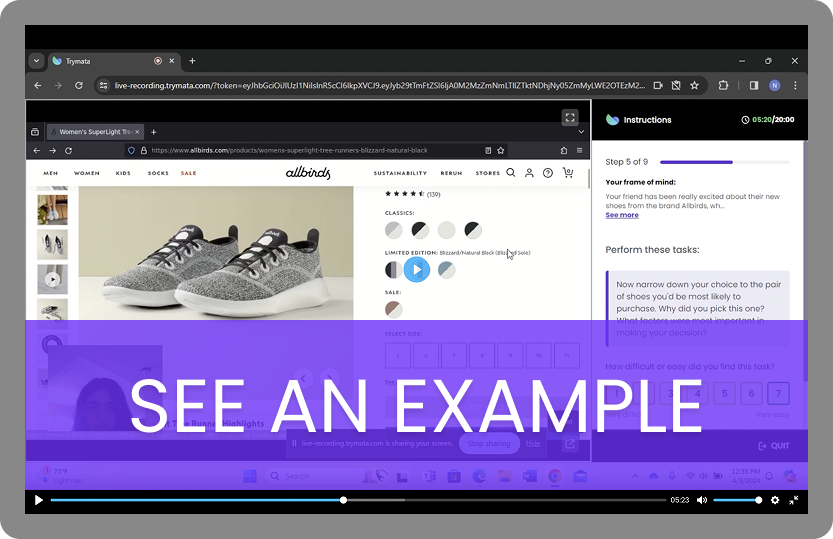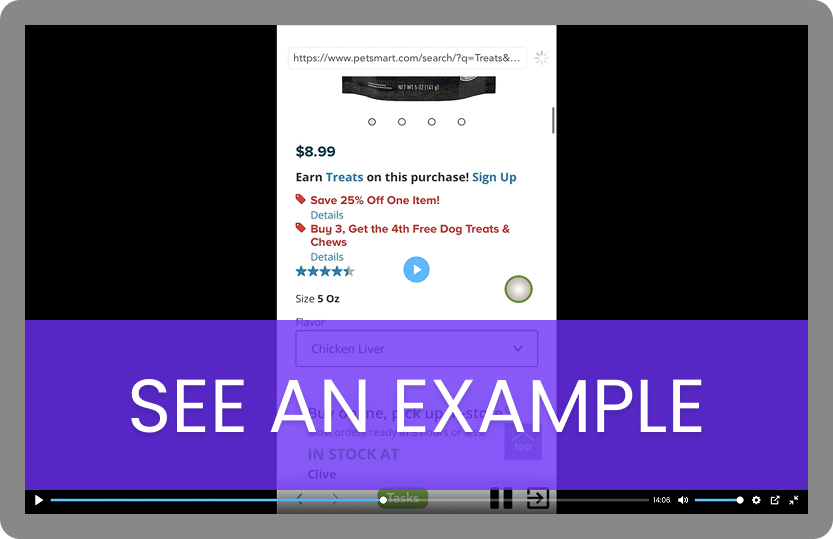- Por qué Trymata
- Plataforma
- Ejemplos
- Recursos
- Planes y precios
- Cobre por hacer pruebas
-
-
Por qué Trymata
-
Plataforma
-
Ejemplos
-
Recursos
Tu amiga está entusiasmada con sus nuevos zapatos de la marca Allbirds, que ha comprado por Internet. Desde que te habló de ellos, sientes curiosidad por la marca. Has decidido visitar el sitio web de Allbirds para ver las opciones de calzado y plantearte comprarte un par.
Lo peor de mi experiencia es que la página principal decía una cosa sobre tener un color de edición limitada para zapatillas (no me dejaba navegar e interactuar con ella) así que tuve que recorrer el camino más largo para intentar encontrar el mismo par que me gustaba. Sin embargo, al encontrarlo, no era coherente, ya que el color no aparecía como opción para las mismas zapatillas que aparecían en la página principal.
Añadir mucha más información sobre sostenibilidad, explicaciones y comparaciones sobre cómo estas zapatillas y prendas de ropa son más sostenibles que las de otros minoristas, y explicar esos datos y cómo se han obtenido. Además, crear un menú de navegación con pestañas en el sitio web para que sea más fácil conocer las diferentes secciones del sitio y poder navegar y encontrar todas las secciones sin perder información. Hacer de la sostenibilidad una prioridad y anunciarla como tal en la parte superior de la página principal y en todo el sitio web.
Me gustó su aspecto moderno y la sostenibilidad que ofrece la empresa con sus zapatos.
No tengo más comentarios que mis sugerencias de mejora. ¡Espero que todo esto sea útil! Valoro mucho la sostenibilidad, la biodegradabilidad, el reciclaje, etc. Me encantaría ver más información en la página web sobre los materiales (cómo son sostenibles) y qué significa eso en cuanto a la durabilidad del calzado y qué hacer cuando se desgasta. Es decir, ¿se puede reciclar? ¿La empresa lo recoge? También me encantaría que, como parte del programa de iniciación a la sostenibilidad, hubiera formas de comprar «productos imperfectos» o «defectuosos» a un precio mucho más bajo, para que estos posibles fallos en los productos no se desperdicien y esto también contribuya a la sostenibilidad, junto con la colaboración con organizaciones conservacionistas como WWF o 4Ocean.
Ha estado mirando algunos artículos nuevos para su perro y decide echar un vistazo por Internet.
3
Como ya he mencionado, el texto de la página de inicio parecía apretado y el diseño general de la página de inicio parecía un poco desordenado. Ninguno de los productos me entusiasmó como usuario.
I like how easy it was to search for things. It was easy to customize my search, so even if they didn’t carry the right brand I could find a replacement.
All accounts, tests, and data have been migrated to our new & improved system!
Use the same email and password to log in:
Legacy login: Our legacy system is still available in view-only mode, login here >


Esta prueba es un ejemplo típico de estudio de usabilidad en escritorio. El sitio web sometido a la prueba, AllBirds, es una zapatería online especializada en materiales ecológicos.
Reclutamos a participantes de nuestro panel que habían comprado antes zapatos de marcas comparables. Después, durante sus sesiones, les hicimos realizar una serie de tareas en el sitio web de AllBirds, empezando por la página de inicio y continuando hasta encontrar y comprobar un par de zapatos.
Opciones de productos imprecisas:La usuaria se sintió frustrada cuando el color de zapato que le gustaba, que aparecía en el listado principal de productos, no aparecía en la página del producto real. "Es un poco engañoso. Mostraba un color de edición limitada en el sitio principal, pero ese color no estaba ahí cuando hice clic".
Falta de detalles sobre los puntos críticos de venta:La usuaria estaba muy interesada en los esfuerzos de sostenibilidad de AllBirds, pero consideraba que el sitio no ofrecía suficientes detalles sobre qué hace que el calzado sea respetuoso con el medio ambiente. Después de consultar la sección de sostenibilidad, no sabía cómo habían conseguido (o medido) su menor huella de carbono, ni si los zapatos eran reciclables.
Estos datos proceden de un solo clip de 12 minutos de un único evaluador. Imagina cuánto más aprenderás sobre tu UX con un estudio de pruebas de usuario completo.

Esta prueba es un ejemplo típico de estudio de usabilidad de un sitio web para móviles. PetSmart es un sitio web de comercio electrónico para encontrar y comprar comida y suministros para mascotas.
Reclutamos a propietarios de perros reales de nuestro panel para que participaran en esta prueba. Luego, durante sus sesiones, les hicimos realizar una serie de tareas en el sitio móvil de PetSmart, empezando por la página de inicio antes de pasar a intentar encontrar productos para su perro.
Diseño móvil deficiente:En varios momentos de la sesión, el usuario comenta que el aspecto y el formato del sitio web son «estrechos» y desordenados, y que no se adaptan bien al uso en un dispositivo móvil.
Confusión en la página del carrito:Al configurar una recogida en tienda, el usuario observa que la información sobre la tienda es algo pequeña y está bastante abajo en la página, por lo que es fácil pasarla por alto. Con un botón «Continuar con la compra» justo en la parte superior de la página, señalan que podrían saltárselo y terminar el proceso con la tienda seleccionada equivocada.
Trymata ofrece pruebas de usuario para aplicaciones móviles, sitios web y prototipos - ¡descubra cómo puede llevar su UX móvil al siguiente nivel!A